AREA OF COMPOUND SHAPES RECTANGLES AND TRIANGLES
Two or more basic shapes put together is known as compound shapes.
Find the area of the following compound shapes (not drawn to scale)
The dashed lines are perpendicular.
Problem 1 :
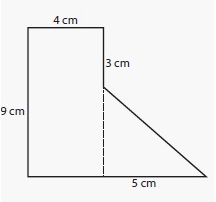
Solution :
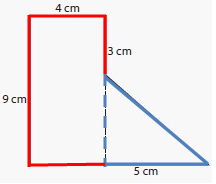
By observing the figure,
Area of a rectangle A = l × w
Length of a rectangle (l) = 4 cm
Width of a rectangle (w) = 9 cm
Area of a rectangle A = 4 × 9
= 36 cm2
Area of a triangle A = 1/2 (b × h)
Base of a triangle (b) = 5 cm
Height of a triangle (h) = 6 cm
= 1/2 (5 × 6)
= 1/2 (30)
= 15 cm2
Area of Compound Shapes = Area of a rectangle + Area of a triangle
= 36 + 15
= 51 cm2
Problem 2 :
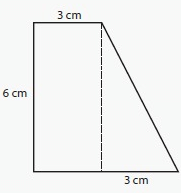
Solution :
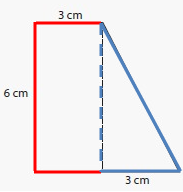
By observing the figure,
Area of a rectangle A = l × w
Length of a rectangle (l) = 3 cm
Width of a rectangle (w) = 6 cm
Area of a rectangle A = 3 × 6
= 18 cm2
Area of a triangle A = 1/2 (b × h)
Base of a triangle (b) = 3 cm
Height of a triangle (h) = 6 cm
= 1/2 (3 × 6)
= 1/2 (18)
= 9 cm2
Area of Compound Shapes = Area of a rectangle + Area of a triangle
= 18 + 9
= 27 cm2
Problem 3 :
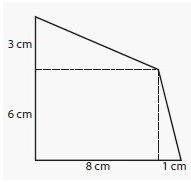
Solution :

By observing the figure,
Area of a rectangle A = l × w
Length of a rectangle (l) = 8 cm
Width of a rectangle (w) = 6 cm
Area of a rectangle A = 8 × 6
= 48 cm2
Area of a triangle A = 1/2 (b × h)
Base of a triangle (b) = 1 cm
Height of a triangle (h) = 6 cm
= 1/2 (1 × 6)
= 1/2 (6)
= 3 cm2
Area of a triangle A = 1/2 (b × h)
Base of a triangle (b) = 8 cm
Height of a triangle (h) = 3 cm
= 1/2 (8 × 3)
= 1/2 (24)
= 12 cm2
Area of Compound Shapes = Area of a rectangle + Area of a triangle + Area of a triangle
= 48+ 3 + 12
= 63 cm2
Problem 4 :
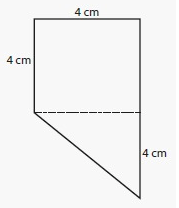
Solution :
By observing the figure,
Area of a rectangle A = l × w
Length of a rectangle (l) = 4 cm
Width of a rectangle (w) = 4 cm
Area of a rectangle A = 4 × 4
= 16 cm2
Area of a triangle A = 1/2 (b × h)
Base of a triangle (b) = 4 cm
Height of a triangle (h) = 4 cm
= 1/2 (4 × 4)
= 1/2 (16)
= 8 cm2
Area of Compound Shapes = Area of a rectangle + Area of a triangle
= 16 + 8
= 24 cm2
Problem 5 :
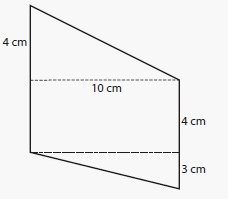
Solution :
By observing the figure,
Area of a rectangle A = l × w
Length of a rectangle (l) = 10 cm
Width of a rectangle (w) = 4 cm
Area of a rectangle A = 10 × 4
= 40 cm2
Area of a triangle A = 1/2 (b × h)
Base of a triangle (b) = 10 cm
Height of a triangle (h) = 3 cm
= 1/2 (10 × 3)
= 1/2 (30)
= 15 cm2
Area of a triangle A = 1/2 (b × h)
Base of a triangle (b) = 10 cm
Height of a triangle (h) = 4 cm
= 1/2 (10 × 4)
= 1/2 (40)
= 20 cm2
Area of Compound Shapes = Area of a rectangle + Area of a triangle + Area of a triangle
= 40 + 15 + 20
= 75 cm2
Problem 6 :

Solution :
By observing the figure,
Area of a rectangle A = l × w
Length of a rectangle (l) = 10 cm
Width of a rectangle (w) = 4 cm
Area of a rectangle A = 10 × 4
= 40 cm2
Area of a triangle A = 1/2 (b × h)
Base of a triangle (b) = 7 cm
Height of a triangle (h) = 6 cm
= 1/2 (7 × 6)
= 1/2 (42)
= 21 cm2
Area of Compound Shapes = Area of a rectangle + Area of a triangle
= 40 + 21
= 61 cm2
Problem 7 :
Find the area of the portion of the basketball court shown.
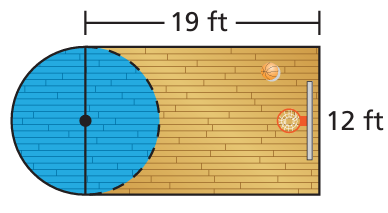
Solution :
The half of the circle is merged in the rectangle and finding out half of the circle is enough.
Area of portion of the basketbal = area of rectangle + (1/2) πr2
Length = 19 ft, width = 12 ft and diameter of circle = 12 ft, radius = 6 ft
= 12 x 19 + (1/2) x 3.14 x 62
= 228 + 1.57 x 36
= 228 + 56.52
= 284.52 square ft.
Problem 8 :
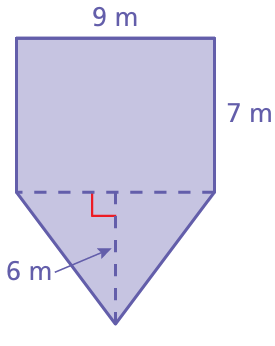
Solution :
Area of compound shape = area of triangle + area of rectangle
= (1/2) x base x height + length x width
= (1/2) x 9 x 6 + 7 x 9
= 27 + 63
= 100 square meter.
Problem 9 :
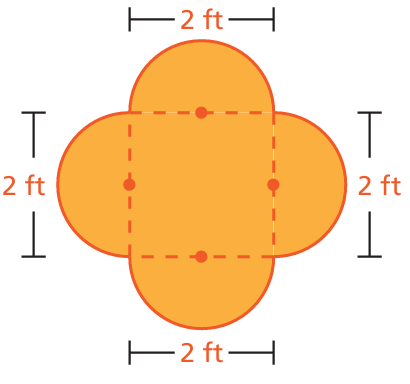
Solution :
Area of compound shape = area of square + 4 (area of semicircle)
= side x side + 4 x (1/2) πr2
= 2 x 2 + 4 x (1/2) x 3.14 x 12
= 4 + 6.28
= 10.58 square ft.
Problem 10 :
The figure is made up of a square and a rectangle. Find the area of the shaded region.
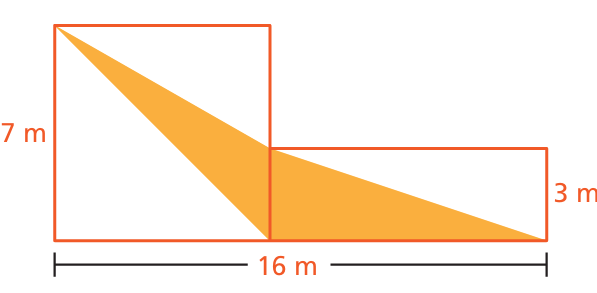
Solution :
base of the triangle to the left = 3 m, since it is the shape of square, height of the triangle = 7 m.
Base of the triangle to the right = 16 - 7 ==> 9 m
height = 3 m
Area of shaded region = 1/2 x 3 x 7 + 1/2 x 9 x 3
= 21/2 + 27/2
= 10.5 + 13.5
= 24 square meter
Recent Articles
-
Finding Range of Values Inequality Problems
May 21, 24 08:51 PM
Finding Range of Values Inequality Problems -
Solving Two Step Inequality Word Problems
May 21, 24 08:51 AM
Solving Two Step Inequality Word Problems -
Exponential Function Context and Data Modeling
May 20, 24 10:45 PM
Exponential Function Context and Data Modeling